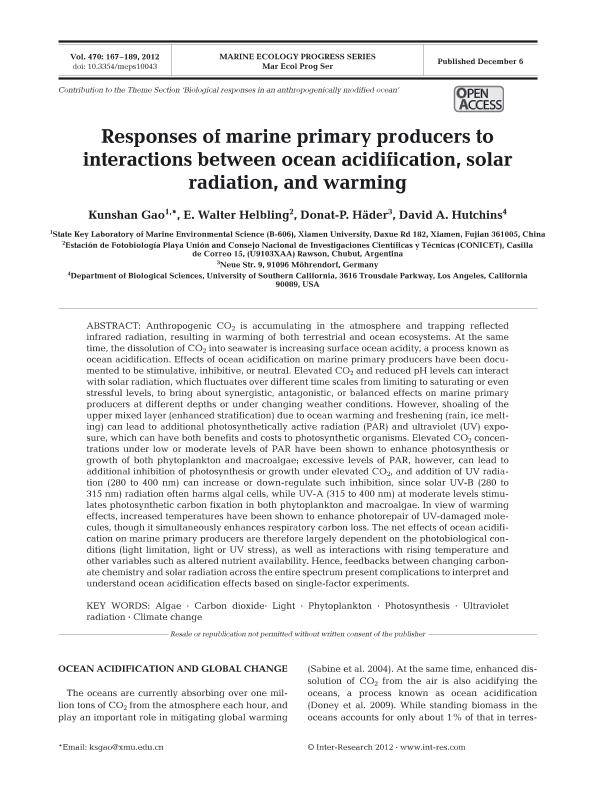Mostrar el registro sencillo del ítem
dc.contributor.author
Gao, Kunshan
dc.contributor.author
Helbling, Eduardo Walter

dc.contributor.author
Häder, Donat P.
dc.contributor.author
Hutchins, David A.
dc.date.available
2023-05-30T14:22:24Z
dc.date.issued
2012-12
dc.identifier.citation
Gao, Kunshan; Helbling, Eduardo Walter; Häder, Donat P.; Hutchins, David A.; Responses of marine primary producers to interactions between ocean acidification, solar radiation, and warming; Inter-Research; Marine Ecology Progress Series; 470; 12-2012; 167-189
dc.identifier.issn
0171-8630
dc.identifier.uri
http://hdl.handle.net/11336/198937
dc.description.abstract
Anthropogenic CO2 is accumulating in the atmosphere and trapping backward infrared radiation, resulting in warming of both terrestrial and ocean ecosystems. At the same time, dissolution of CO2 into seawater is increasing surface ocean acidity, a process known as ocean acidification. Phytoplankton cells in natural environments experience diurnal changes of solar radiation, from light-limiting to light-saturating and then, most often in upper layers, to stressful light levels in the presence of UV radiation. Subsequently, ocean acidification can interact with solar radiation to bring about synergistic, antagonistic or balanced effects on marine primary producers at different depths or under changing weather conditions. In fact, both solar radiation and pCO2 can fluctuate over different time scales to range from limiting to saturating or even stressful levels. On the other hand, shoaling of the upper mixed layer (enhanced stratification) due to ocean warming and freshening (rain, ice melting) can lead to additional photosynthetically active radiation (PAR) and ultraviolet (UV) exposure, which can have both benefits and costs to photosynthetic organisms. Within limits, elevated CO2 concentrations under low or moderate levels of PAR have been shown to act synergistically benefiting photosynthesis or growth in both marine phytoplankton and macroscopic algae; excessive levels of PAR, however, can lead to additional inhibition of photosynthesis or growth under elevated CO2, and addition of UV radiation (280-400 nm) can increase such inhibition. While solar UV-B (280-315 nm) radiation often harms algal cells, UV-A (315-400 nm) at moderate levels stimulates photosynthetic carbon fixation in both phytoplankton and macroalgae. Both the inhibitory impacts of UV-B and stimulatory effects of UV-A vary in amplitude with changes in seawater chemistry associated with ocean acidification. In view of warming effects, increased temperatures have been shown to enhance photorepair of UV-damaged molecules, though it simultaneously enhances respiratory carbon loss. The net effects of ocean acidification on marine primary producers are therefore largely dependent on the photobiological conditions (light limitation, light or UV stress), as well as interactions with rising temperature and other variables such as altered nutrient availability. Hence, feedbacks between changing carbonate chemistry and solar radiation across the entire spectrum present complications to interpret and understand ocean acidification effects based on single-factor experiments.
dc.format
application/pdf
dc.language.iso
eng
dc.publisher
Inter-Research

dc.rights
info:eu-repo/semantics/openAccess
dc.rights.uri
https://creativecommons.org/licenses/by-nc-sa/2.5/ar/
dc.subject
ALGAE
dc.subject
CARBON DIOXIDE
dc.subject
CLIMATE CHANGE
dc.subject
LIGHT
dc.subject
PHOTOSYNTHESIS
dc.subject
PHYTOPLANKTON
dc.subject
ULTRAVIOLET RADIATION
dc.subject.classification
Biología Marina, Limnología

dc.subject.classification
Ciencias Biológicas

dc.subject.classification
CIENCIAS NATURALES Y EXACTAS

dc.title
Responses of marine primary producers to interactions between ocean acidification, solar radiation, and warming
dc.type
info:eu-repo/semantics/article
dc.type
info:ar-repo/semantics/artículo
dc.type
info:eu-repo/semantics/publishedVersion
dc.date.updated
2023-05-29T12:15:08Z
dc.journal.volume
470
dc.journal.pagination
167-189
dc.journal.pais
Alemania

dc.description.fil
Fil: Gao, Kunshan. Xiamen University; China
dc.description.fil
Fil: Helbling, Eduardo Walter. Fundación Playa Unión. Estación de Fotobiología Playa Unión; Argentina. Consejo Nacional de Investigaciones Científicas y Técnicas; Argentina
dc.description.fil
Fil: Häder, Donat P.. No especifíca;
dc.description.fil
Fil: Hutchins, David A.. University of Southern California; Estados Unidos. University of Southern California; Estados Unidos
dc.journal.title
Marine Ecology Progress Series

dc.relation.alternativeid
info:eu-repo/semantics/altIdentifier/url/https://www.int-res.com/abstracts/meps/v470/p167-189/
dc.relation.alternativeid
info:eu-repo/semantics/altIdentifier/doi/http://dx.doi.org/10.3354/meps10043
Archivos asociados
